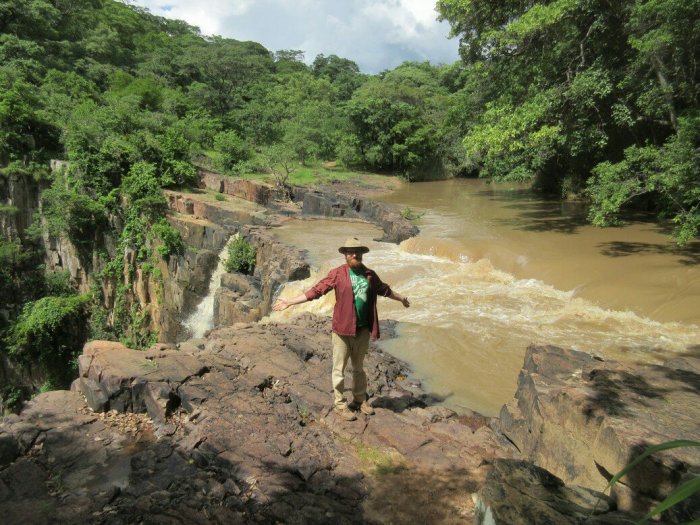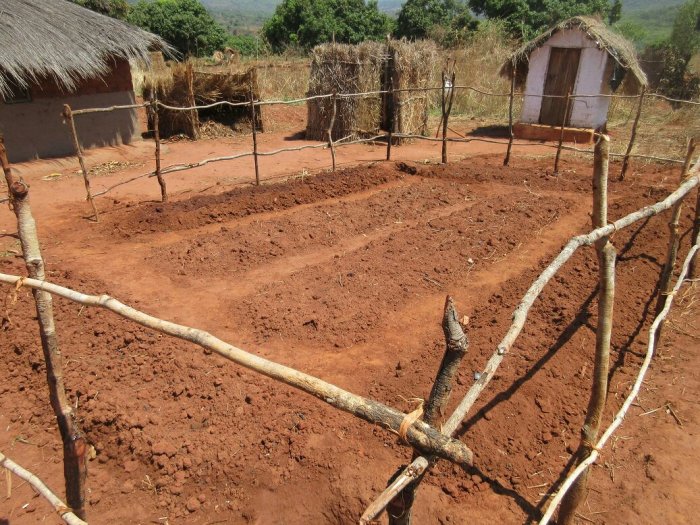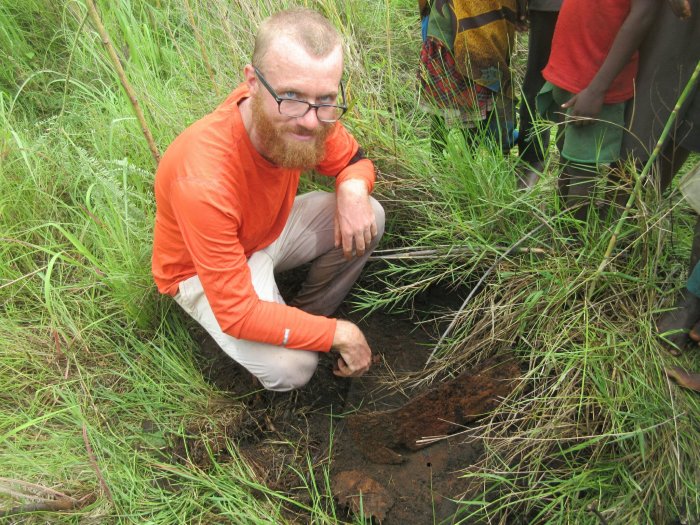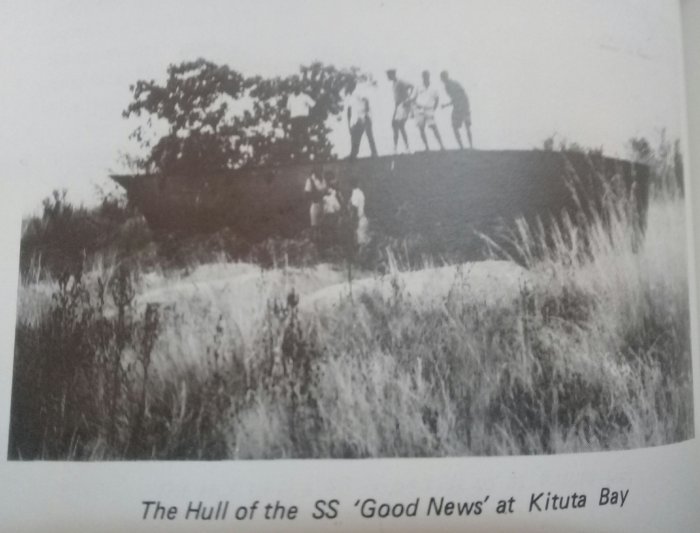 For Christmas, Lily came up to visit my site in the Mbala area. While she was up here, we went to go visit Kalambo Falls. We stayed at the Kalambo Falls Lodge, which is right next to the falls. Getting to the falls is a 40ish km ride from Mbala over a pretty terrible road, but at least it is a very scenic drive so it’s got that going for it. Kalambo Falls Lodge is pretty new and when we stayed there we were the only two people, so that was neat.
For Christmas, Lily came up to visit my site in the Mbala area. While she was up here, we went to go visit Kalambo Falls. We stayed at the Kalambo Falls Lodge, which is right next to the falls. Getting to the falls is a 40ish km ride from Mbala over a pretty terrible road, but at least it is a very scenic drive so it’s got that going for it. Kalambo Falls Lodge is pretty new and when we stayed there we were the only two people, so that was neat.  After arriving at the lodge and unpacking, we walked down to the path to start checking out the falls. We were the only visitors at the time. There is a well-maintained concrete path that takes you to various viewing areas and to the top of the falls. Kalambo Falls is notable for being the highest waterfall in Zambia at about 222m. This is far taller than Victoria Falls, but of course far less wide. Kalambo Falls is also the second highest waterfall in all of Africa, and the 12th highest in the world, so, you know, quite an attraction. Kalambo Falls is on the Kalambo river, and forms the border between Zambia and Tanzania.
After arriving at the lodge and unpacking, we walked down to the path to start checking out the falls. We were the only visitors at the time. There is a well-maintained concrete path that takes you to various viewing areas and to the top of the falls. Kalambo Falls is notable for being the highest waterfall in Zambia at about 222m. This is far taller than Victoria Falls, but of course far less wide. Kalambo Falls is also the second highest waterfall in all of Africa, and the 12th highest in the world, so, you know, quite an attraction. Kalambo Falls is on the Kalambo river, and forms the border between Zambia and Tanzania.  Lily, overlooking the falls and wondering when I’ll be done. Besides its physical characteristics, Kalambo Falls is known for being an extensive archealogical site, with evidence for habitation at least 200,000 years old. I’ve read on other sites that you can walk to some of these sites, but the guide when I was there didn’t seem to think it was possible. Maybe he was just keeping me away. He did point to a cave at the bottom of the gorge where he said they found artifacts.
Lily, overlooking the falls and wondering when I’ll be done. Besides its physical characteristics, Kalambo Falls is known for being an extensive archealogical site, with evidence for habitation at least 200,000 years old. I’ve read on other sites that you can walk to some of these sites, but the guide when I was there didn’t seem to think it was possible. Maybe he was just keeping me away. He did point to a cave at the bottom of the gorge where he said they found artifacts.  Even without seeing the ancient man sorta stuff, the site is fantastically beautiful. Most people visit the lodge by hiking up from one of the lodges on the shore of Lake Tang, but since we were staying at the lodge we got to see the site in both the evening and the morning. The falls plunge into a deep gorge lined with mysterious-looking jungle. At the bottom, the Kalambo river winds the last 6km to Lake Tang. Standing on the edge looking down at the birds swooping around gives a massive sense of vertigo. There are some baboons in the area (thankfully a lot more scared of people than the Victoria Falls brand) which we managed to catch a glimpse of. Kalambo Falls is gorgeous and I recommend anyone in the Mbala area do their best to go take a look. There can’t be many more places in the world like it.
Even without seeing the ancient man sorta stuff, the site is fantastically beautiful. Most people visit the lodge by hiking up from one of the lodges on the shore of Lake Tang, but since we were staying at the lodge we got to see the site in both the evening and the morning. The falls plunge into a deep gorge lined with mysterious-looking jungle. At the bottom, the Kalambo river winds the last 6km to Lake Tang. Standing on the edge looking down at the birds swooping around gives a massive sense of vertigo. There are some baboons in the area (thankfully a lot more scared of people than the Victoria Falls brand) which we managed to catch a glimpse of. Kalambo Falls is gorgeous and I recommend anyone in the Mbala area do their best to go take a look. There can’t be many more places in the world like it.
Month: December 2017
Gardening

One of my sunflower beds, yes I am aware they’re probably too close.
Reading this week:
- Baltasar and Blimunda by José Saramago
Besides fish farming, I have also taken up gardening. The only real reason for me to garden is to get some street cred. Everyone farms so if you don’t farm it is kinda weird. When I say everybody I mean everybody. You bike through Mbala and people got maize growing in their front yards, and in Lusaka I see it growing in the median in the roads downtown. Everybody farms.

My project started with a permagarden by the side of my house. Permagardens are designed to be high-output and to retain water well. This lets you keep a small, easy to maintain garden next to your house to ensure both food security and a variety of foods to ensure good nutrition. The above picture is with the garden finished but before I planted. The beds are dug extra deep and have a good amount of manure (as fertilizer), ash (for minerals and to balance pH), and charcoal dust (to help the soil retain moisture).

This is the garden a few weeks after I finally planted it. Its contents are a pretty random assortment of whatever seeds I happened to have. In the lower right is velvet bean, and in the lower left I tried to grow peppers, thusfar with no success. The middle has watermelon and then onions & carrots (apparently these are better as companion plantings). The upper left has pigeon pea and the upper right has green ram. The garden is in desperate need of weeding, but I am writing blog posts to procrastinate doing that.

My farm.
The next project was to plant some sunflowers. Sunflowers are good for fish farming because after you press the seeds for oil, you can use the oilcake for fish feed. I had what I thought was a small amount of sunflower seeds, but man a small amount goes a long way. My house is on a little plot of land my host family used the previous year for maize. I started digging sunflower beds and then wouldn’t stop until I was finished with all my seeds. For every two beds of sunflowers, I planted one bed of either green gram or velvet bean to put nitrogen in the soil. This was a lot of work and I insisted on doing it all myself.
I finished the sunflower seeds with a bit of room to spare, so I made six ridges and planted those with orange-fleshed sweet potatoes. After the workshop we planted the roots we received and my host dad did some rapid vine multiplication so we had plenty of vines. I am pretty amazed when seeds work, so this whole vegetative multiplication thing I was wary of. It seems, however, to be working. My only regret now is that I don’t have more room; I managed to get some seeds for orange maize and that would have been cool to have.
Fish Pond Update
 Reading this week:
Reading this week:
- Mona Lisa Overdrive by William Gibson
- East of Eden by John Steinbeck
No big adventures this week, so I thought I would give an update on the fish ponds; they’re doing well! My host dad has constructed a total of four ponds; three are in the above picture with another one in a higher tier on the left. He’s in the process of building two more, but construction has stopped due to the rainy season. That’ll make a total of six ponds for him, which is a convenient number as you can theoretically harvest every month with a six-month growth cycle. Next to his ponds are two more ponds owned by another farmer.  All the ponds have been stocked. The photo above is my host dad stocking one of the ponds. He got involved in an experiment on supplemental feeds. He has been supplied with commercial feed, and also makes his own feed. One pond he’ll provide commercial feed, and the other pond he’ll give the feed he makes. When we harvest we’ll see which fish grew the best.
All the ponds have been stocked. The photo above is my host dad stocking one of the ponds. He got involved in an experiment on supplemental feeds. He has been supplied with commercial feed, and also makes his own feed. One pond he’ll provide commercial feed, and the other pond he’ll give the feed he makes. When we harvest we’ll see which fish grew the best.  My host dad feeding fish. If I had one criticism of the ponds, it is that they don’t have a very good bloom. With rainy season we are getting more mud and run-off into the ponds, which makes it harder to tell if we have a good bloom and is also not great for the fish. The fish don’t seem to be suffering too much for it so I am not worried, and he’s been good about providing feed so the fish are growing no matter what.
My host dad feeding fish. If I had one criticism of the ponds, it is that they don’t have a very good bloom. With rainy season we are getting more mud and run-off into the ponds, which makes it harder to tell if we have a good bloom and is also not great for the fish. The fish don’t seem to be suffering too much for it so I am not worried, and he’s been good about providing feed so the fish are growing no matter what.  My host dad has been doing a lot of work to improve the ponds. He’s in the process of building a fence around the ponds to keep out predators. He always refers to it as “preventing THE predator,” like there is a particular lizard that is his nemesis or as if there is an alien hunter eating his fish. He also invented the above contraption. My host dad fertilizes his ponds with manure, and the usual RAP suggestion is to put the manure in a sack to place in the pond. He has instead made a basket out of mealie meal sacks and suspended it on four sticks. This has the same effect of holding the manure in a certain location, but makes it a lot easier to add manure just by dumping it in the top. I’m looking forward to harvesting these ponds in February or March and seeing how the fish have grown. At that point we’ll have completed all parts of the fish farming cycle, and both my farmers and I will have had hands-on experience with all portions of it. My big hope is that once people see my host dad make money after the fish harvest, everyone will be exited about fish farming and come to me wanting to stake ponds.
My host dad has been doing a lot of work to improve the ponds. He’s in the process of building a fence around the ponds to keep out predators. He always refers to it as “preventing THE predator,” like there is a particular lizard that is his nemesis or as if there is an alien hunter eating his fish. He also invented the above contraption. My host dad fertilizes his ponds with manure, and the usual RAP suggestion is to put the manure in a sack to place in the pond. He has instead made a basket out of mealie meal sacks and suspended it on four sticks. This has the same effect of holding the manure in a certain location, but makes it a lot easier to add manure just by dumping it in the top. I’m looking forward to harvesting these ponds in February or March and seeing how the fish have grown. At that point we’ll have completed all parts of the fish farming cycle, and both my farmers and I will have had hands-on experience with all portions of it. My big hope is that once people see my host dad make money after the fish harvest, everyone will be exited about fish farming and come to me wanting to stake ponds.
I Found the SS Good News!
 Me, with a section of the SS Good News. Reading this week:
Me, with a section of the SS Good News. Reading this week:
- Churchill’s History of the English Speaking Peoples, arranged for one volume by Henry Steele Commager
Today my efforts to find the SS Good News finally met with success. I set off on my expedition at about 0600. I overpacked; I brought enough food along with camping equipment to spend a night out in the bush, but I wound up making the whole trip in one day. From my hut I followed some bush paths and then a rather nice dirt road to Kituta Bay, where a guidebook to Zambian National Monuments said I would find the Good News. Kituta Bay is gorgeous. It’s the next bay over to the east of Mpulungu harbor, and the valley opens up into this (today anyways) sun-dappled valley surrounded by mountains. I started wandering the valley, looking for what I assumed would be a fairly obvious, 50 ft long metal hull sitting out in the open. This wasn’t a terrible assumption, based on this picture from a 1991 guidebook to Zambia’s National Monuments:
 Sorry it’s a terrible picture. As I was wandering around a dude asked me where I was going and I said I was looking for the Good News. He pointed me to a clump of trees and I head that way, thinking the ship had been overgrown in the intervening years. I dragged my bike towards the shore until my feet were submerged and put it up against a tree, and continued wandering around looking for the ship. Eventually, to my surprise, some kid called my name. Turns out he’s the brother of one of my neighbors, and knew about me. I tried to ask him about the boat, but he didn’t know, so I continued tramping through a marsh, supported at times just by floating mats of grass. Eventually the kid brought a slightly older guy around, and I showed him the picture I had (the same one above) of the boat. He asked me if it was the Good News and when I was like hell yeah and that I would follow him. He lead me over to a clump of tall grass and as I looked around for a hull he started digging.
Sorry it’s a terrible picture. As I was wandering around a dude asked me where I was going and I said I was looking for the Good News. He pointed me to a clump of trees and I head that way, thinking the ship had been overgrown in the intervening years. I dragged my bike towards the shore until my feet were submerged and put it up against a tree, and continued wandering around looking for the ship. Eventually, to my surprise, some kid called my name. Turns out he’s the brother of one of my neighbors, and knew about me. I tried to ask him about the boat, but he didn’t know, so I continued tramping through a marsh, supported at times just by floating mats of grass. Eventually the kid brought a slightly older guy around, and I showed him the picture I had (the same one above) of the boat. He asked me if it was the Good News and when I was like hell yeah and that I would follow him. He lead me over to a clump of tall grass and as I looked around for a hull he started digging. A chunk of the SS Good News. Turns out in the 30 or so years since the picture was taken for that guidebook, the ship has apparently fallen over and been buried. We dug up several portions of the boat. As far as I can tell, it is indeed the ship and not a 50 gallon drum or anything. I assume there’s not a whole lot of metal ships laying around anyways, and the whole area seemed big enough to match the ship and the parts looked like riveted ship hull sections. I was very happy to have finally sighted the ship but a little dissapointed there wasn’t more to look at. But I can say for sure that, despite what you read on other websites, the SS Good News is buried at the very center of the bay, but you’ll have to ask around to find it.
Loaded up in the boat, paddling out to the bay. At this point, I asked the dude showing me around if it was possible for him to take me to Mpulungu. I didn’t want to bike the 2500m of vertical elevation change back up to my site, and was hoping to catch a minibus out of Mpulungu. He offered to take me for K100 which I thought was a pretty good deal. So we found a boat, loaded up my bike, and started paddling across the bay.
I had imagined paddling all the way around to Mpulungu, but after paddling across the bay the dudes taking me concluded it would be easier to walk over the hill separating Kituta Bay and Mpulungu. I am glad we did. We walked through a gorgeous village (named Kipata, I think) which had massive trees, a really nice bridge over a small river, and a waterfall. I am glad I got to see that. Once we got to the hill, the dudes split the load and one dude shouldered my bike and we hiked over the hill like that. At this point I realized I had accidentally hired porters, colonial-style, and I didn’t know how to feel about that. But it was pretty cool.
After hiking over the hill, the guys deposited me on the road to Mpulungu and I biked the rest of the way in. Despite it being Sunday I found an open bar and rewarded myself with a beer.After my beers I caught a minibus to Mbala and biked home. It was a great adventure and I was super excited to have laid eyes on the hulk of the SS Good News. Hopefully the next person looking for the boat has an easier time than I did!
Mushroom Workshop
 The cultivation center of a model mushroom farmer. Reading this week:
The cultivation center of a model mushroom farmer. Reading this week:
- Star.Ships: A Prehistory of the Spirits by Gordon White
- Death in the Clouds by Agatha Christie
This week I attended the mushroom workshop. This took place in Lusaka and is another thing I’m pretty excited about implementing in the village. Although the workshop itself was a Peace Corps event, the training was conducted by China Aid, the PRC’s international development agency. This marks a new stage in my historically tumultuous relationship with the PRC. But anyways. They have a big research center on the outskirts of Lusaka, and from the looks of it focus on agricultural techniques (and the growing of Chinese vegetables, from the looks of their garden; I spent some time thinking about stereotypical things to focus on, development-wise *cough* JICA and rice *cough,* but that’s probably a topic best left to scholars or whatever). One of their big specialties is mushroom growing, and that’s of course why we were there. Mushrooms can be a pretty excellent crop for a farmer. They grow on agricultural waste products, like corn cobs or elephant grass, are easy to grow, are rich in vitamins and stuff, and sell pretty well. China Aid will sell, at a low price, bags of cultivated mushroom mycelium. All the farmer does with these is cut a few holes and wait for mushrooms to grow. This isn’t really very sustainable, because the farmer would have to keep buying these cultivated mycelium all the way from Lusaka (and transport them to their farm, like I did; they’re basically bags of mold and it was a little weird to carry around). So the workshop focused on mushroom spawning.  My biggest criticism of the workshop is that it wasn’t very village-based. They did talk about the technologies you would use in the village, but it was mostly along the lines of “…and if you don’t happen to have an autoclave, you can use an old oil drum!” However, with work, it does seem very possible in the village to grow mushrooms all the way from scratch, eliminating the need to buy cultivated products from China. I am excited to give it a whirl. Maybe once I am back in the States I can use my skills to sell like artisan mushrooms and the local farmer’s market. Hand crafted!
My biggest criticism of the workshop is that it wasn’t very village-based. They did talk about the technologies you would use in the village, but it was mostly along the lines of “…and if you don’t happen to have an autoclave, you can use an old oil drum!” However, with work, it does seem very possible in the village to grow mushrooms all the way from scratch, eliminating the need to buy cultivated products from China. I am excited to give it a whirl. Maybe once I am back in the States I can use my skills to sell like artisan mushrooms and the local farmer’s market. Hand crafted!  On a final note, the other awesome part of the China Aid research complex is a sweet basketball court. We had driven by the place many times but never seen anyone play, until now. Between sessions there was a pickup game or two, which for any passerbys must have been kinda confusing. But there we go.
On a final note, the other awesome part of the China Aid research complex is a sweet basketball court. We had driven by the place many times but never seen anyone play, until now. Between sessions there was a pickup game or two, which for any passerbys must have been kinda confusing. But there we go.